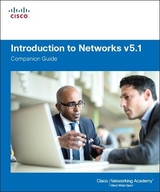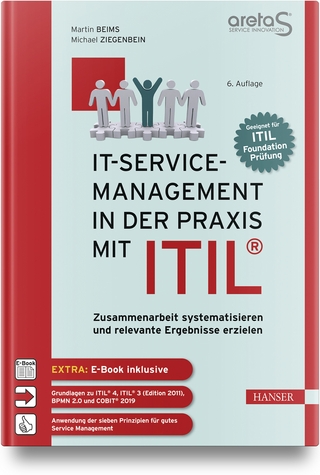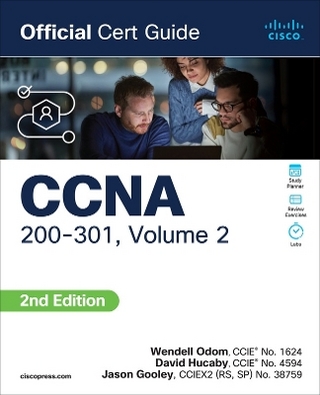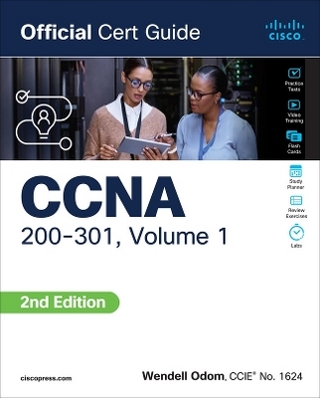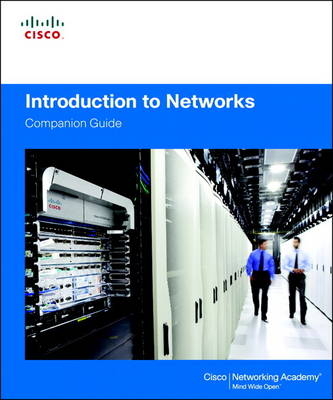
Introduction to Networks Companion Guide
Cisco Press (Verlag)
978-1-58713-316-9 (ISBN)
- Titel erscheint in neuer Auflage
- Artikel merken
The course introduces the architecture, structure, functions, components, and models of the Internet and computer networks. The principles of IP addressing and fundamentals of Ethernet concepts, media, and operations are introduced to provide a foundation for the curriculum. By the end of the course, you will be able to build simple LANs, perform basic configurations for routers and switches, and implement IP addressing schemes.
The Companion Guide is designed as a portable desk reference to use anytime, anywhere to reinforce the material from the course and organize your time.
The book’s features help you focus on important concepts to succeed in this course:
Chapter Objectives–Review core concepts by answering the focus questions listed at the beginning of each chapter.
Key Terms–Refer to the lists of networking vocabulary introduced and highlighted in context in each chapter.
Glossary–Consult the comprehensive Glossary with more than 195 terms.
Summary of Activities and Labs–Maximize your study time with this complete list of all associated practice exercises at the end of each chapter.
Check Your Understanding–Evaluate your readiness with the end-of-chapter questions that match the style of questions you see in the online course quizzes. The answer key explains each answer.
Related Title:
Introduction to Networks Lab Manual
ISBN-10: 1-58713-312-1
ISBN-13: 978-1-58713-312-1
How To–Look for this icon to study the steps you need to learn to perform certain tasks.
Interactive Activities–Reinforce your understanding of topics with more than 50 different exercises from the online course identified throughout the book with this icon.
Videos–Watch the videos embedded within the online course.
Packet Tracer Activities–Explore and visualize networking concepts using Packet Tracer exercises interspersed throughout the chapters.
Hands-on Labs–Work through all 66 course labs and Class Activities that are included in the course and published in the separate Lab Manual.
This book is part of the Cisco Networking Academy Series from Cisco Press®. Books in this series support and complement the Cisco Networking Academy curriculum.
Introduction xxvi
Chapter 1 Exploring the Network 1
Objectives 1
Key Terms 1
Introduction (1.0.1.1) 3
Globally Connected (1.1) 4
Networking Today (1.1.1) 4
Networks in Our Daily Lives (1.1.1.1) 4
Technology Then and Now (1.1.1.2) 5
The Global Community (1.1.1.3) 6
Networks Support the Way We Learn (1.1.1.4) 7
Networks Support the Way We Communicate (1.1.1.5) 8
Networks Support the Way We Work (1.1.1.6) 10
Networks Support the Way We Play (1.1.1.7) 10
Providing Resources in a Network (1.1.2) 11
Networks of Many Sizes (1.1.2.1) 12
Clients and Servers (1.1.2.2, 1.1.2.3) 13
Peer-to-Peer (1.1.2.4) 13
LANs, WANs, and the Internet (1.2) 14
Components of a Network (1.2.1, 1.2.1.1) 15
End Devices (1.2.1.2) 16
Intermediary Network Devices (1.2.1.3) 16
Network Media (1.2.1.4) 17
Network Representations (1.2.1.5) 18
Topology Diagrams (1.2.1.6) 19
LANs and WANs (1.2.2) 21
Types of Networks (1.2.2.1) 21
Local-Area Networks (1.2.2.2) 22
Wide-Area Networks (1.2.2.3) 22
The Internet (1.2.3, 1.2.3.1) 22
Intranet and Extranet (1.2.3.2) 23
Internet Access Technologies (1.2.4.1) 25
Connecting Remote Users to the Internet (1.2.4.2) 25
Connecting Businesses to the Internet (1.2.4.3) 27
The Network as a Platform (1.3) 28
The Converging Network (1.3.1.1) 29
Planning for the Future (1.3.1.2) 30
The Supporting Network Architecture (1.3.2.1) 31
Fault Tolerance in Circuit-Switched Networks (1.3.2.2) 32
Fault Tolerance 32
Circuit-Switched Connection-Oriented Networks 33
Fault Tolerance in Packet-Switched Networks (1.3.2.3) 34
Packet-Switched Networks 34
Scalable Networks (1.3.2.4) 35
Scalability 35
Providing QoS (1.3.2.5) 37
Quality of Service 37
Providing Network Security (1.3.2.6) 39
Security 39
The Changing Network Environment (1.4) 41
Network Trends (1.4.1) 41
New Trends (1.4.1.1) 41
Bring Your Own Device (BYOD) (1.4.1.2) 43
Online Collaboration (1.4.1.3) 43
Video Communication (1.4.1.4) 44
Cloud Computing (1.4.1.5) 46
Data Centers (1.4.1.6) 47
Technology Trends in the Home (1.4.2.1) 48
Powerline Networking (1.4.2.2) 49
Wireless Broadband (1.4.2.3) 50
Wireless Internet Service Provider (WISP) 50
Wireless Broadband Service 50
Security Threats (1.4.3.1) 50
Security Solutions (1.4.3.2) 51
Cisco Network Architectures (1.4.4.1) 52
CCNA (1.4.4.2) 53
Summary (1.5) 54
Practice 55
Class Activities 55
Labs 55
Packet Tracer Activities 55
Check Your Understanding 56
Chapter 2 Configuring a Network Operating System 59
Objectives 59
Key Terms 59
Introduction (2.0.1) 60
Introduction to Cisco IOS (2.0.1.1) 60
IOS Boot Camp (2.1) 61
Cisco IOS (2.1.1) 61
Operating Systems (2.1.1.1) 61
Purpose of OS (2.1.1.2) 63
Location of the Cisco IOS (2.1.1.3) 63
IOS Functions (2.1.1.4) 64
Accessing a Cisco IOS Device (2.1.2) 65
Console Access Method (2.1.2.1) 65
Telnet, SSH, and AUX Access Methods (2.1.2.2) 66
Terminal Emulation Programs (2.1.2.3) 67
Navigating the IOS (2.1.3) 67
Cisco IOS Modes of Operation (2.1.3.1) 68
Primary Modes (2.1.3.2) 69
Global Configuration Mode and Submodes (2.1.3.3) 69
Navigating Between IOS Modes (2.1.3.4, 2.1.3.5) 71
The Command Structure (2.1.4) 72
IOS Command Structure (2.1.4.1) 73
Cisco IOS Command Reference (2.1.4.2) 75
Context-Sensitive Help (2.1.4.3) 76
Command Syntax Check (2.1.4.4) 78
Hot Keys and Shortcuts (2.1.4.5) 79
IOS Examination Commands (2.1.4.6) 83
The show version Command (2.1.4.7) 83
Getting Basic (2.2) 86
Host Names (2.2.1) 86
Why the Switch (2.2.1.1) 86
Device Names (2.2.1.2) 87
Host Names (2.2.1.3) 87
Configuring Host Names (2.2.1.4) 88
Limiting Access to Device Configurations (2.2.2) 89
Securing Device Access (2.2.2.1) 89
Securing Privileged EXEC Access (2.2.2.2) 90
Securing User EXEC Access (2.2.2.3) 91
Encrypting Password Display (2.2.2.4) 92
Banner Messages (2.2.2.5) 94
Saving Configurations (2.2.3) 96
Configuration Files (2.2.3.1) 96
Capturing Text (2.2.3.2) 98
Address Schemes (2.3) 100
Ports and Addresses (2.3.1) 100
IP Addressing of Devices (2.3.1.1) 100
Interfaces and Ports (2.3.1.2) 101
Addressing Devices (2.3.2) 102
Configuring a Switch Virtual Interface (2.3.2.1) 102
Manual IP Address Configuration for End Devices (2.3.2.2) 103
Automatic IP Address Configuration for End Devices (2.3.2.3) 104
IP Address Conflicts (2.3.2.4) 105
Verifying Connectivity (2.3.3) 106
Test the Loopback Address on an End Device (2.3.3.1) 106
Testing the Interface Assignment (2.3.3.2) 107
Testing End-to-End Connectivity (2.3.3.3) 108
Summary (2.4) 109
Practice 110
Class Activities 110
Labs 111
Packet Tracer Activities 111
Check Your Understanding 111
Chapter 3 Network Protocols and Communications 115
Objectives 115
Key Terms 115
Introduction (3.0.1.1) 116
Rules of Communication (3.1) 116
The Rules (3.1.1) 117
What Is Communication? (3.1.1.1) 117
Establishing the Rules (3.1.1.2) 118
Message Encoding (3.1.1.3) 119
Message Formatting and Encapsulation (3.1.1.4) 120
Message Size (3.1.1.5) 121
Message Timing (3.1.1.6) 121
Message Delivery Options (3.1.1.7) 122
Network Protocols and Standards (3.2) 123
Protocols (3.2.1) 123
Protocols: Rules That Govern Communications (3.2.1.1) 123
Network Protocols (3.2.1.2) 124
Interaction of Protocols (3.2.1.3) 125
Protocol Suites (3.2.2) 127
Protocol Suites and Industry Standards (3.2.2.1) 127
Creation of the Internet and Development of TCP/IP (3.2.2.2) 128
TCP/IP Protocol Suite and Communication Process (3.2.2.3) 129
Standards Organizations (3.2.3) 133
Open Standards (3.2.3.1) 133
ISOC, IAB, and IETF (3.2.3.2) 134
IEEE (3.2.3.3) 135
ISO (3.2.3.4) 136
Other Standards Organizations (3.2.3.5) 136
Reference Models (3.2.4) 137
The Benefits of Using a Layered Model (3.2.4.1) 138
The OSI Reference Model (3.2.4.2) 139
The TCP/IP Protocol Model (3.2.4.3) 140
Comparing the OSI Model with the TCP/IP Model (3.2.4.4) 141
Moving Data in the Network (3.3) 143
Data Encapsulation (3.3.1) 143
Communicating the Messages (3.3.1.1) 143
Protocol Data Units (PDU) (3.3.1.2) 144
Encapsulation (3.3.1.3) 145
Deencapsulation (3.3.1.4) 146
Accessing Local Resources (3.3.2) 146
Network Addresses and Data-Link Addresses (3.3.2.1) 146
Communicating with a Device on the Same Network (3.3.2.2) 148
MAC and IP Addresses (3.3.2.3) 149
Accessing Remote Resources (3.3.3) 150
Default Gateway (3.3.3.1) 150
Communicating with a Device on a Remote Network (3.3.3.2) 151
Summary (3.4) 154
Practice 155
Class Activities 155
Labs 155
Packet Tracer Activities 155
Check Your Understanding 156
Chapter 4 Network Access 161
Objectives 161
Key Terms 161
Introduction (4.0.1.1) 163
Physical Layer Protocols (4.1) 164
Getting It Connected (4.1.1) 164
Connecting to the Network (4.1.1.1) 164
Network Interface Cards (4.1.1.2) 165
Purpose of the Physical Layer (4.1.2) 166
The Physical Layer (4.1.2.1) 166
Physical Layer Media (4.1.2.2) 167
Physical Layer Standards (4.1.2.3) 168
Fundamental Principles of Layer 1 (4.1.3) 169
Physical Layer Fundamental Principles (4.1.3.1) 169
Bandwidth (4.1.3.2) 171
Throughput (4.1.3.3) 172
Types of Physical Media (4.1.3.4) 173
Network Media (4.2) 173
Copper Cabling (4.2.1) 173
Characteristics of Copper Media (4.2.1.1) 173
Copper Media (4.2.1.2) 175
Unshielded Twisted-Pair Cable (4.2.1.3) 176
Shielded Twisted-Pair (STP) Cable (4.2.1.4) 176
Coaxial Cable (4.2.1.5) 177
Copper Media Safety (4.2.1.6) 178
UTP Cabling (4.2.2) 179
Properties of UTP Cabling (4.2.2.1) 179
UTP Cabling Standards (4.2.2.2) 180
UTP Connectors (4.2.2.3) 182
Types of UTP Cable (4.2.2.4) 183
Testing UTP Cables (4.2.2.5) 185
Fiber-Optic Cabling (4.2.3) 185
Properties of Fiber-Optic Cabling (4.2.3.1) 185
Fiber Media Cable Design (4.2.3.2) 186
Types of Fiber Media (4.2.3.3) 187
Network Fiber Connectors (4.2.3.4) 189
Testing Fiber Cables (4.2.3.5) 191
Fiber Versus Copper (4.2.3.6) 192
Wireless Media (4.2.4) 193
Properties of Wireless Media (4.2.4.1) 193
Types of Wireless Media (4.2.4.2) 194
Wireless LAN (4.2.4.3) 196
802.11 Wi-Fi Standards (4.2.4.4) 196
Data Link Layer Protocols (4.3) 198
Purpose of the Data Link Layer (4.3.1) 198
The Data Link Layer (4.3.1.1) 198
Data Link Sublayers (4.3.1.2) 199
Media Access Control (4.3.1.3) 200
Providing Access to Media (4.3.1.4) 201
Layer 2 Frame Structure (4.3.2) 202
Formatting Data for Transmission (4.3.2.1) 202
Creating a Frame (4.3.2.2) 203
Layer 2 Standards (4.3.3) 204
Data Link Layer Standards (4.3.3.1) 204
Media Access Control (4.4) 205
Topologies (4.4.1) 206
Controlling Access to the Media (4.4.1.1) 206
Physical and Logical Topologies (4.4.1.2) 207
WAN Topologies (4.4.2) 208
Common Physical WAN Topologies (4.4.2.1) 208
Physical Point-to-Point Topology (4.4.2.2) 209
Logical Point-to-Point Topology (4.4.2.3) 209
Half and Full Duplex (4.4.2.4) 210
LAN Topologies (4.4.3) 210
Physical LAN Topologies (4.4.3.1) 210
Logical Topology for Shared Media (4.4.3.2) 211
Contention-Based Access (4.4.3.3) 212
Multiaccess Topology (4.4.3.4) 213
Controlled Access (4.4.3.5) 213
Ring Topology (4.4.3.6) 214
Data-Link Frame (4.4.4) 215
The Frame (4.4.4.1) 215
The Header (4.4.4.2) 215
Layer 2 Address (4.4.4.3) 216
The Trailer (4.4.4.4) 217
LAN and WAN Frames (4.4.4.5) 218
Ethernet Frame (4.4.4.6) 220
PPP Frame (4.4.4.7) 221
802.11 Wireless Frame (4.4.4.8) 222
Summary (4.5) 225
Practice 227
Class Activities 227
Labs 227
Packet Tracer Activities 227
Check Your Understanding 227
Chapter 5 Ethernet 231
Objectives 231
Key Terms 231
Introduction (5.0.1.1) 233
Ethernet Protocol (5.1) 234
Ethernet Operation (5.1.1) 234
LLC and MAC Sublayers (5.1.1.1) 235
MAC Sublayer (5.1.1.2) 235
Media Access Control (5.1.1.3) 236
MAC Address: Ethernet Identity (5.1.1.4) 238
Frame Processing (5.1.1.5) 239
Ethernet Frame Attributes (5.1.2) 240
Ethernet Encapsulation (5.1.2.1) 241
Ethernet Frame Size (5.1.2.2) 242
Introduction to the Ethernet Frame (5.1.2.3) 243
Ethernet MAC (5.1.3) 244
MAC Addresses and Hexadecimal (5.1.3.1) 244
MAC Address Representations (5.1.3.2) 246
Unicast MAC Address (5.1.3.3) 247
Broadcast MAC Address (5.1.3.4) 248
Multicast MAC Address (5.1.3.5) 248
MAC and IP (5.1.4, 5.1.4.1) 249
End-to-End Connectivity, MAC, and IP (5.1.4.2) 250
Address Resolution Protocol (5.2, 5.2.1, 5.2.1.1) 252
ARP Functions (5.2.1.2) 252
ARP Operation (5.2.1.3) 253
ARP Role in Remote Communication (5.2.1.4) 256
Removing Entries from an ARP Table (5.2.1.5) 258
ARP Tables on Networking Devices (5.2.1.6) 258
ARP Issues (5.2.2) 259
How ARP Can Create Problems (5.2.2.1) 259
Mitigating ARP Problems (5.2.2.2) 260
LAN Switches (5.3) 260
Switching (5.3.1) 260
Switch Port Fundamentals (5.3.1.1) 261
Switch MAC Address Table (5.3.1.2) 261
Duplex Settings (5.3.1.3) 263
Auto-MDIX (5.3.1.4) 265
Frame-Forwarding Methods on Cisco Switches (5.3.1.5) 265
Cut-Through Switching (5.3.1.6) 266
Memory Buffering on Switches (5.3.1.8) 267
Fixed or Modular (5.3.2) 268
Fixed Versus Modular Configuration (5.3.2.1) 268
Module Options for Cisco Switch Slots (5.3.2.2) 270
Layer 3 Switching (5.3.3) 272
Layer 2 Versus Layer 3 Switching (5.3.3.1) 272
Cisco Express Forwarding (5.3.3.2) 273
Types of Layer 3 Interfaces (5.3.3.3) 274
Configuring a Routed Port on a Layer 3 Switch (5.3.3.4) 275
Summary (5.4) 277
Practice 278
Class Activities 278
Labs 279
Packet Tracer Activities 279
Check Your Understanding 279
Chapter 6 Network Layer 283
Objectives 283
Key Terms 283
Introduction (6.0.1.1) 284
Network Layer Protocols (6.1) 285
Network Layer in Communication (6.1.1) 285
The Network Layer (6.1.1.1) 285
Network Layer Protocols (6.1.1.2) 286
Characteristics of the IP Protocol (6.1.2) 287
Characteristics of IP (6.1.2.1) 287
IP—Connectionless (6.1.2.2) 288
IP—Best-Effort Delivery (6.1.2.3) 288
IP—Media Independent (6.1.2.4) 289
Encapsulating IP (6.1.2.5) 290
IPv4 Packet (6.1.3) 291
IPv4 Packet Header (6.1.3.1) 291
IPv4 Header Fields (6.1.3.2) 293
Sample IPv4 Headers (6.1.3.3) 293
IPv6 Packet (6.1.4) 295
Limitations of IPv4 (6.1.4.1) 295
Introducing IPv6 (6.1.4.2) 296
Encapsulating IPv6 (6.1.4.3) 297
IPv6 Packet Header (6.1.4.4) 298
Sample IPv6 Header (6.1.4.5) 298
Routing (6.2) 299
How a Host Routes (6.2.1) 299
Host Forwarding Decision (6.2.1.1) 300
Default Gateway (6.2.1.2) 300
IPv4 Host Routing Table (6.2.1.3) 301
IPv4 Host Routing Entries (6.2.1.4) 303
Sample IPv4 Host Routing Table (6.2.1.5) 305
Sample IPv6 Host Routing Table (6.2.1.6) 306
Router Routing Tables (6.2.2) 307
Router Packet-Forwarding Decision (6.2.2.1) 307
IPv4 Router Routing Table (6.2.2.2) 308
Directly Connected Routing Table Entries (6.2.2.3) 310
Remote Network Routing Table Entries (6.2.2.4) 311
Next-Hop Address (6.2.2.5) 312
Sample Router IPv4 Routing Table (6.2.2.6) 312
Routers (6.3) 315
Anatomy of a Router (6.3.1) 315
A Router Is a Computer (6.3.1.1) 315
Router CPU and OS (6.3.1.2) 315
Router Memory (6.3.1.3) 316
Inside a Router (6.3.1.4) 318
Router Backplane (6.3.1.5) 319
Connecting to a Router (6.3.1.6) 320
LAN and WAN Interfaces (6.3.1.7) 321
Router Bootup (6.3.2) 322
Cisco IOS (6.3.2.1) 322
Bootset Files (6.3.2.2) 323
Router Bootup Process (6.3.2.3) 323
Show Version Output (6.3.2.4) 325
Configuring a Cisco Router (6.4) 326
Configure Initial Settings (6.4.1) 326
Router Configuration Steps (6.4.1.1) 326
Configure Interfaces (6.4.2) 328
Configure LAN Interfaces (6.4.2.1) 328
Verify Interface Configuration (6.4.2.2) 330
Configuring the Default Gateway (6.4.3) 332
Default Gateway on a Host (6.4.3.1) 332
Default Gateway on a Switch (6.4.3.2) 333
Summary (6.5) 335
Practice 336
Class Activities 337
Labs 337
Packet Tracer Activities 337
Check Your Understanding 337
Chapter 7 Transport Layer 341
Objectives 341
Key Terms 341
Introduction (7.0.1.1) 342
Learning Objectives 342
Transport Layer Protocols (7.1) 343
Transportation of Data (7.1.1) 343
Role of the Transport Layer (7.1.1.1, 7.1.1.2) 343
Conversation Multiplexing (7.1.1.3) 347
Transport Layer Reliability (7.1.1.4) 347
TCP (7.1.1.5) 348
UDP (7.1.1.6) 349
The Right Transport Layer Protocol for the Right
Application (7.1.1.7) 350
Introducing TCP and UDP (7.1.2) 352
Introducing TCP (7.1.2.1) 352
Role of TCP (7.1.2.2) 353
Introducing UDP (7.1.2.3) 355
Role of UDP (7.1.2.4) 355
Separating Multiple Communications (7.1.2.5) 356
TCP and UDP Port Addressing (7.1.2.6 – 7.1.2.9) 357
TCP and UDP Segmentation (7.1.2.10) 362
TCP and UDP (7.2) 363
TCP Communication (7.2.1) 364
TCP Reliable Delivery (7.2.1.1) 364
TCP Server Processes (7.2.1.2) 364
TCP Connection Establishment and Termination (7.2.1.3) 365
TCP Three-Way Handshake Analysis—Step 1 (7.2.1.4) 367
TCP Three-Way Handshake Analysis—Step 2 (7.2.1.5) 368
TCP Three-Way Handshake Analysis—Step 3 (7.2.1.6) 369
TCP Session Termination Analysis (7.2.1.7) 370
Reliability and Flow Control (7.2.2) 373
TCP Reliability—Ordered Delivery (7.2.2.1) 373
TCP Reliability—Acknowledgement and Window Size (7.2.2.2) 374
TCP Reliability—Data Loss and Retransmission (7.2.2.3) 376
TCP Flow Control—Window Size and Acknowledgements (7.2.2.4) 376
TCP Flow Control—Congestion Avoidance (7.2.2.5) 378
UDP Communication (7.2.3) 379
UDP Low Overhead Versus Reliability (7.2.3.1) 379
UDP Datagram Reassembly (7.2.3.2) 380
UDP Server Processes and Requests (7.2.3.3) 381
UDP Client Processes (7.2.3.4) 381
TCP or UDP, That Is the Question (7.2.4) 382
Applications That Use TCP (7.2.4.1) 382
Applications That Use UDP (7.2.4.2) 382
Summary (7.3) 384
Practice 386
Class Activities 386
Labs 386
Packet Tracer Activities 386
Check Your Understanding 386
Chapter 8 IP Addressing 391
Objectives 391
Key Terms 391
Introduction (8.0.1.1) 393
IPv4 Network Addresses (8.1) 393
IPv4 Address Structure (8.1.1) 394
Binary Notation (8.1.1.1) 394
Binary Number System (8.1.1.2) 395
Converting a Binary Address to Decimal (8.1.1.3) 397
Converting from Decimal to Binary (8.1.1.5, 8.1.1.6) 399
IPv4 Subnet Mask (8.1.2) 400
Network Portion and Host Portion of an IPv4 Address (8.1.2.1) 400
Examining the Prefix Length (8.1.2.2) 402
IPv4 Network, Host, and Broadcast Addresses (8.1.2.3) 403
First Host and Last Host Addresses (8.1.2.4) 405
Bitwise AND Operation (8.1.2.5) 406
Importance of ANDing (8.1.2.6) 407
IPv4 Unicast, Broadcast, and Multicast (8.1.3) 408
Assigning a Static IPv4 Address to a Host (8.1.3.1) 408
Assigning a Dynamic IPv4 Address to a Host (8.1.3.2) 409
Unicast Transmission (8.1.3.3) 410
Broadcast Transmission (8.1.3.4) 412
Multicast Transmission (8.1.3.5) 413
Types of IPv4 Addresses (8.1.4) 416
Public and Private IPv4 Addresses (8.1.4.1) 416
Special-Use IPv4 Addresses (8.1.4.3) 417
Legacy Classful Addressing (8.1.4.4) 419
Assignment of IP Addresses (8.1.4.5, 8.1.4.6) 422
IPv6 Network Addresses (8.2) 424
IPv4 Issues (8.2.1) 424
The Need for IPv6 (8.2.1.1) 425
IPv4 and IPv6 Coexistence (8.2.1.2) 426
IPv6 Addressing (8.2.2) 427
Hexadecimal Number System (8.2.2.1) 427
IPv6 Address Representation (8.2.2.2) 429
Rule 1: Omit Leading 0s (8.2.2.3) 430
Rule 2: Omit All 0 Segments (8.2.2.4) 430
Types of IPv6 Addresses (8.2.3) 431
IPv6 Address Types (8.2.3.1) 431
IPv6 Prefix Length (8.2.3.2) 432
IPv6 Unicast Addresses (8.2.3.3) 432
IPv6 Link-Local Unicast Addresses (8.2.3.4) 434
IPv6 Unicast Addresses (8.2.4) 435
Structure of an IPv6 Global Unicast Address (8.2.4.1) 435
Static Configuration of a Global Unicast Address (8.2.4.2) 437
Dynamic Configuration of a Global Unicast Address Using SLAAC (8.2.4.3) 439
Dynamic Configuration of a Global Unicast Address
Using DHCPv6 (8.2.4.4) 441
EUI-64 Process or Randomly Generated (8.2.4.5) 442
Dynamic Link-Local Addresses (8.2.4.6) 444
Static Link-Local Addresses (8.2.4.7) 445
Verifying IPv6 Address Configuration (8.2.4.8) 447
IPv6 Multicast Addresses (8.2.5) 449
Assigned IPv6 Multicast Addresses (8.2.5.1) 449
Solicited-Node IPv6 Multicast Addresses (8.2.5.2) 450
Connectivity Verification (8.3) 451
ICMP (8.3.1) 451
ICMPv4 and ICMPv6 Messages (8.3.1.1) 451
ICMPv6 Router Solicitation and Router Advertisement Messages (8.3.1.2) 453
ICMPv6 Neighbor Solicitation and Neighbor
Advertisement Messages (8.3.1.3) 454
Testing and Verification (8.3.2) 455
Ping: Testing the Local Stack (8.3.2.1) 455
Ping: Testing Connectivity to the Local LAN (8.3.2.2) 456
Ping: Testing Connectivity to Remote (8.3.2.3) 456
Traceroute: Testing the Path (8.3.2.4) 456
Summary (8.4) 460
Practice 461
Class Activities 462
Labs 462
Packet Tracer Activities 462
Check Your Understanding 462
Chapter 9 Subnetting IP Networks 465
Objectives 465
Key Terms 465
Introduction (9.0.1.1) 466
Subnetting an IPv4 Network (9.1) 467
Network Segmentation (9.1.1) 467
Reasons for Subnetting (9.1.1.1) 467
Communication Between Subnets (9.1.1.2) 468
IP Subnetting Is FUNdamental (9.1.2) 468
The Plan (9.1.2.1) 468
The Plan: Address Assignment (9.1.2.2) 470
Subnetting an IPv4 Network (9.1.3) 470
Basic Subnetting (9.1.3.1) 470
Subnets in Use (9.1.3.2) 472
Subnetting Formulas (9.1.3.3) 474
Creating Four Subnets (9.1.3.4) 475
Creating Eight Subnets (9.1.3.5) 478
Creating 100 Subnets with a /16 prefix (9.1.3.10) 481
Calculating the Hosts (9.1.3.11) 483
Calculating the Hosts (9.1.3.12) 484
Determining the Subnet Mask (9.1.4) 487
Subnetting Based on Host Requirements (9.1.4.1) 487
Subnetting Network-Based Requirements (9.1.4.2) 488
Subnetting to Meet Network Requirements (9.1.4.3, 9.1.4.4) 488
Benefits of Variable-Length Subnet Masking (9.1.5) 492
Traditional Subnetting Wastes Addresses (9.1.5.1) 492
Variable-Length Subnet Masks (VLSM) (9.1.5.2) 493
Basic VLSM (9.1.5.3) 494
VLSM in Practice (9.1.5.4) 495
VLSM Chart (9.1.5.5) 496
Addressing Schemes (9.2) 498
Structured Design (9.2.1) 498
Planning to Address the Network (9.2.1.1) 498
Assigning Addresses to Devices (9.2.1.2) 499
Design Considerations for IPv6 (9.3) 501
Subnetting an IPv6 Network (9.3.1) 501
Subnetting Using the Subnet ID (9.3.1.1) 502
IPv6 Subnet Allocation (9.3.1.2) 503
Subnetting into the Interface ID (9.3.1.3) 505
Summary (9.4) 507
Practice 508
Class Activities 508
Labs 509
Packet Tracer Activities 509
Check Your Understanding 509
Chapter 10 Application Layer 515
Objectives 515
Key Terms 515
Introduction (10.0.1.1) 516
Application Layer Protocols (10.1) 517
Application, Session, and Presentation (10.1.1) 517
OSI and TCP/IP Models Revisited (10.1.1.1) 517
Application Layer (10.1.1.2) 518
Presentation and Session Layers (10.1.1.3) 518
TCP/IP Application Layer Protocols (10.1.1.4) 519
How Application Protocols Interact with End-User Applications (10.1.2) 520
Peer-to-Peer Networks (10.1.2.1) 520
Peer-to-Peer Applications (10.1.2.2) 521
Common P2P Applications (10.1.2.3) 522
Client-Server Model (10.1.2.5) 523
Well-Known Application Layer Protocols and Services (10.2) 525
Common Application Layer Protocols (10.2.1) 525
Application Layer Protocols Revisited (10.2.1.1) 525
Hypertext Transfer Protocol and Hypertext Markup Language (10.2.1.2) 525
HTTP and HTTPS (10.2.1.3) 526
SMTP, POP, and IMAP (10.2.1.4-10.2.1.7) 527
Providing IP Addressing Services (10.2.2) 530
Domain Name System (10.2.2.1) 530
DNS Message Format (10.2.2.2) 530
DNS Hierarchy (10.2.2.3) 532
Nslookup (10.2.2.4) 533
Dynamic Host Configuration Protocol (10.2.2.6) 534
DHCPv4 Operation (10.2.2.7) 535
Providing File-Sharing Services (10.2.3) 538
File Transfer Protocol (10.2.3.1) 538
Server Message Block (10.2.3.4) 539
The Message Heard Around the World (10.3) 540
Move It! (10.3.1) 540
The Internet of Things (10.3.1.1) 540
Message Travels Through a Network (10.3.1.2) 540
Getting the Data to the End Device (10.3.1.3) 542
Getting the Data Through the Internetwork (10.3.1.4) 542
Getting the Data to the Right Application (10.3.1.5) 543
Warriors of the Net (10.3.1.6) 545
Summary (10.4) 546
Practice 548
Class Activities 548
Labs 548
Packet Tracer Activities 548
Check Your Understanding 549
Chapter 11 It’s a Network 551
Objectives 551
Key Terms 551
Introduction (11.0.1.1) 552
Create and Grow (11.1) 553
Devices in a Small Network (11.1.1) 553
Small-Network Topologies (11.1.1.1) 553
Device Selection for a Small Network (11.1.1.2) 554
IP Addressing for a Small Network (11.1.1.3) 555
Redundancy in a Small Network (11.1.1.4) 556
Design Considerations for a Small Network (11.1.1.5) 557
Protocols in a Small Network (11.1.2) 559
Common Applications in a Small Network (11.1.2.1) 559
Common Protocols in a Small Network (11.1.2.2) 560
Real-Time Applications for a Small Network (11.1.2.3) 561
Growing to Larger Networks (11.1.3) 562
Scaling a Small Network (11.1.3.1) 562
Protocol Analysis of a Small Network (11.1.3.2) 563
Evolving Protocol Requirements (11.1.3.3) 564
Keeping the Network Safe (11.2) 564
Network Device Security Measures (11.2.1) 565
Categories of Threats to Network Security (11.2.1.1) 565
Physical Security (11.2.1.2) 566
Types of Security Vulnerabilities (11.2.1.3) 566
Vulnerabilities and Network Attacks (11.2.2) 569
Viruses, Worms, and Trojan Horses (11.2.2.1) 569
Reconnaissance Attacks (11.2.2.2) 570
Access Attacks (11.2.2.3) 570
DoS Attacks (11.2.2.4) 572
Mitigating Network Attacks (11.2.3) 574
Backup, Upgrade, Update, and Patch (11.2.3.1) 574
Authentication, Authorization, and Accounting (11.2.3.2) 575
Firewalls (11.2.3.3) 577
Endpoint Security (11.2.3.4) 578
Securing Devices (11.2.4) 578
Introduction to Securing Devices (11.2.4.1) 578
Passwords (11.2.4.2) 579
Basic Security Practices (11.2.4.3) 580
Enable SSH (11.2.4.4) 581
Basic Network Performance (11.3) 583
Ping (11.3.1) 583
Interpreting Ping Results (11.3.1.1) 583
Extended Ping (11.3.1.2) 585
Network Baseline (11.3.1.3) 586
Tracert (11.3.2) 587
Interpreting Tracert Messages (11.3.2.1) 587
Show Commands (11.3.3) 588
Common Show Commands Revisited (11.3.3.1) 588
Viewing Router Settings with the show version Command (11.3.3.2) 593
Viewing Switch Settings with the show version Command (11.3.3.3) 595
Host and IOS Commands (11.3.4) 595
ipconfig Command Options (11.3.4.1) 595
arp Command Options (11.3.4.2) 597
show cdp neighbors Command Options (11.3.4.3) 597
Using the show ip interface brief Command (11.3.4.4) 600
Managing IOS Configuration Files (11.4) 603
Router and Switch File Systems (11.4.1) 603
Router File Systems (11.4.1.1) 603
Switch File Systems (11.4.1.2) 606
Back Up and Restore Configuration Files (11.4.2) 607
Backing Up and Restoring Using Text Files (11.4.2.1) 607
Backing Up and Restoring Using TFTP (11.4.2.2) 608
Using USB Ports on a Cisco Router (11.4.2.3) 609
Backing Up and Restoring Using a USB Flash Drive (11.4.2.4) 610
Integrated Routing Services (11.5) 611
Integrated Router (11.5.1) 611
Multifunction Device (11.5.1.1) 611
Types of Integrated Routers (11.5.1.2) 613
Wireless Capability (11.5.1.3) 614
Basic Security of Wireless (11.5.1.4) 615
Configuring the Integrated Router (11.5.2) 616
Configuring the Integrated Router (11.5.2.1) 616
Enabling Wireless (11.5.2.2) 617
Configure a Wireless Client (11.5.2.3) 618
Summary (11.6) 620
Practice 622
Class Activities 622
Labs 622
Packet Tracer Activities 623
Check Your Understanding Questions 623
Appendix A Answers to the “Check Your Understanding” Questions 627
Glossary 641
TOC, 9781587133169, 11/7/2013
| Erscheint lt. Verlag | 31.12.2013 |
|---|---|
| Verlagsort | Indianapolis |
| Sprache | englisch |
| Maße | 207 x 241 mm |
| Gewicht | 1258 g |
| Themenwelt | Mathematik / Informatik ► Informatik ► Netzwerke |
| Informatik ► Weitere Themen ► Zertifizierung | |
| ISBN-10 | 1-58713-316-4 / 1587133164 |
| ISBN-13 | 978-1-58713-316-9 / 9781587133169 |
| Zustand | Neuware |
| Haben Sie eine Frage zum Produkt? |
aus dem Bereich
